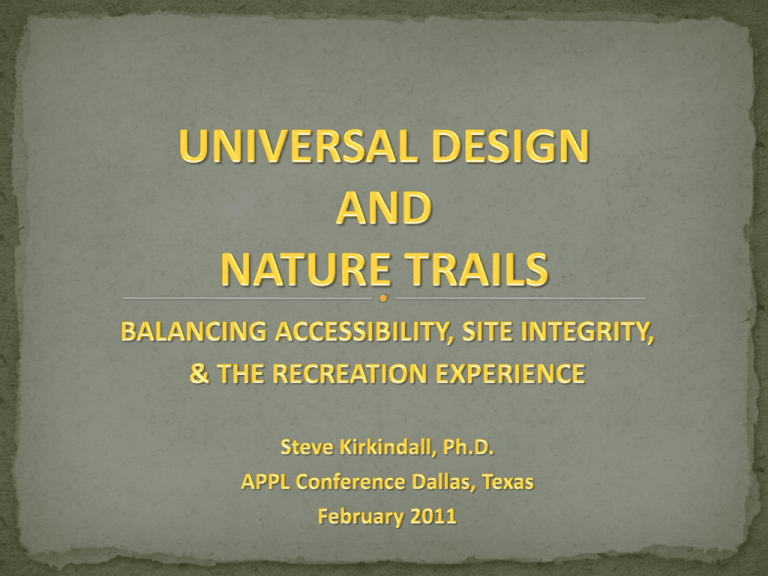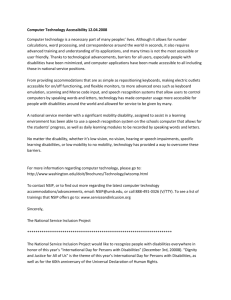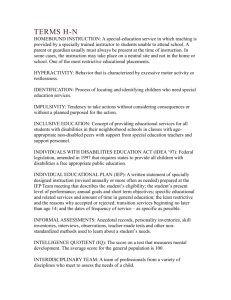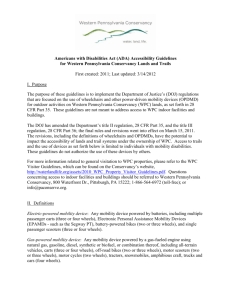universal design and nature trails - Association of Partners for Public
advertisement

Undefined standards Too costly Too few disabled users Increased liability Site impacts Encourages a comprehensive and integrated view of people (with and without disabilities). UD considers anthropometrics, spatial requirements, and other needs of people with disabilities and accommodates these needs in a fashion that also addresses the abilities and needs of the able-bodied population, incorporating features designed to accommodate both groups. Universal – doesn’t refer to all trails Universal – doesn’t refer to the broadest spectrum of human uses, but rather, the broadest spectrum of human abilities A common sense approach to accessibility that: Minimizes physical and social barriers for visitors with disabilities Minimizes creation of aesthetic barriers or detractors Facilitates connections with nature for all users Preserves and protects the integrity of the resource 50 + Million Americans have some level of disability Conservatively – (20 %) of the population – @ ½ of those have severe disabilities; however, 85% of all disabilities are not obvious Only @ 8 million of the nearly 30 million people with mobility impairments use wheelchairs, walkers, canes or other assistive devices Ambulatory – (6.9 %) Independent Living – (5.5 %) Cognitive – (4.8 %) Hearing – (3.5 %) Visual – (2.3 %) Disabilities associated with extremes of size & weight, shortness of breath, lack of stamina, etc. AND THEN … Factor in friends, families, and loved ones of individuals with disabilities … and you easily have somewhere between 1/3 and ½ the population of America whose choice of activities is limited by accessibility issues. AND THEN SOME … The Great Outdoors is for everyone. Universal Design allows us to make it accessible to the broadest possible range of individuals, regardless of the type or extent of their disabilities. 1918 – Smith-Sears Veteran’s Rehabilitation Act 1959 – Tentative Guide: Facilities in Public Buildings for Persons With Ambulatory Impairments, (York) 1968 – Architectural Barriers Act 1970 – The Urban Mass Transit Act 1973 – Rehabilitation Act 1990 – Americans With Disabilities Act 1997 – Regulatory Negotiation Committee on Outdoor Recreation Developed Areas 2004 – ADA-ABA Accessibility Guidelines 2007 – Access Board Notice of Proposed Rulemaking FINAL ACCESSIBILITY GUIDELINES FOR OUTDOOR DEVELOPED AREAS – The Access Board Covers requirements for: Camping facilities Picnic facilities Viewing areas Access routes Beach access Trails PLUS all elements contained within those facilities (drinking fountains, parking areas, restrooms, play areas, boating facilities, fishing platforms, etc) All federal land management agencies State or local government entities Private entities Non-profit organizations (that design, construct, or alter any facilities on federal lands intended for public use) AND, under ADA Title II & III , all other “public accommodations “ that include trails open to the public on privately or commercially managed lands Exceptions to specific technical provisions are permitted where certain conditions exist: Routine maintenance or repair to existing facilities Compliance is not feasible due to terrain Compliance cannot be accomplished with prevailing construction practices Compliance would fundamentally alter the function or purpose of the facility or setting Compliance is precluded by: ESA, NEPA, NHPA, Wilderness Act, etc Determine what portions of trail cannot fully comply Document the basis for determinations and maintain records for the project All portions must comply to the maximum extent feasible Determine if it is impracticable for entire trail to comply Federal agencies are required to notify the Access Board when exempting an entire trail * The Access Board has the legal authority to require a trail to be rebuilt if a complaint is filed by any member of the public as to a lack of accessibility on the trail … if it (the Board) determines the trail is not compliant with the Guidelines. The Board will decide if the trail designer/builder’s decision to not make the entire trail comply with guidelines was or was not “reasonable” … based only on their judgement. WHEELCHAIR ACCOMMODATIONS AS BASELINE FOR ACCESSIBILITY • Surface material • Sustained running slope • Maximum slope • Cross slope • Clear width • Tread obstacles • Edge protection • Passing/resting space intervals New DOJ ruling adopts a two-tiered approach to mobility devices, drawing distinctions between wheelchairs and “other power-driven mobility devices” to be allowed for use on trails by individuals with mobility disabilities. So, what the heck is an OPDMD? “any mobility device powered by batteries, fuel, or other engines – whether or not designed primarily for use by individuals with mobility disabilities – that is used by individuals with mobility disabilities for the purpose of locomotion …” In short, anything with a motor that can be driven, regardless of size or horsepower, if it is driven by a person who has a mobility related disability … including: Anyone who can provide “credible assurance” that the OPDMD is required because of the person’s disability “CREDIBLE ASSURANCE” can be a valid, state-issued disability parking placard or card, or other stateissued proof of disability … or … lacking any of those, the person may simply say the OPDMD is being used for a mobility disability Every entity open to the public must make reasonable modifications in its policies, practices, or procedures to allow the use of OPDMDs by individuals with mobility disabilities, UNLESS: that entity can document that it has completed an assessment of the facility, trail, route, or area, BEFORE the person requesting use of the device arrived onsite, and determined that class of OPDMD could not be used at that location due to one or more DOJ assessment factors The type, size, weight, dimensions, & speed of the device The volume of pedestrian traffic The design & operational characteristics of the facility Whether legitimate safety requirements can be established to permit the safe operation of the device Whether the use of the device creates a substantial risk of serious harm to the immediate environment or natural or cultural resources, or poses a conflict with Federal land management laws and regulations Assess and determine which OPDMDs are permitted or excluded from your site Clearly state the circumstances under which the devices are permitted or excluded Provide clear, concise statements of specific rules governing the operation of such devices Provide public notice of policies regarding use of OPDMDs and what rules apply to the operation of those devices US Architectural and Transportation Barriers Compliance www.access-board.gov Dept of Justice www.ada.gov American Trails www.AmericanTrails.org Beneficial Designs www.beneficialdesigns.com Steve Kirkindall, Ph.D. mskphd@yahoo.com










